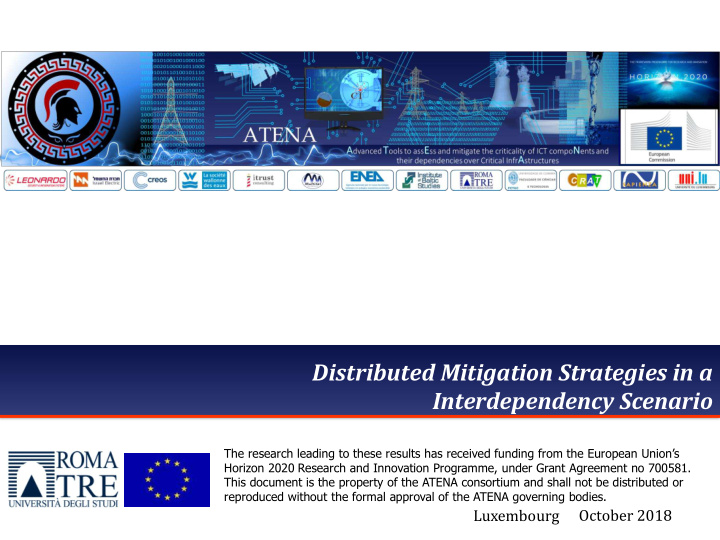



Distributed Mitigation Strategies in a Interdependency Scenario The research leading to these results has received funding from the European Union’s Horizon 2020 Research and Innovation Programme, under Grant Agreement no 700581. This document is the property of the ATENA consortium and shall not be distributed or reproduced without the formal approval of the ATENA governing bodies. Luxembourg October 2018
Overview 2
Mitigation Strategies Overview Starting point Can interdependency play a positive role? 3
Mitigation Strategies Overview Starting point Make better decisions Increase Resilience Increase Awareness Evaluate impacts 4
Risk Predictor 5
Risk Predictor Modelling Approach Agent-Based Simulator The Risk Predictor assess the consequences of adverse events. The Risk Predictor is an agent-based modelling An agent-based modelling simulates interactions among agents in an attempt to predict the effects on the system as a whole of complex phenomena. Salgado M., Gilbert N. (2013) Agent Based Modelling. In: Teo T. (eds) Handbook of Quantitative Methods for Educational Research. Springer, Rotterdam Bandini, S., Manzoni, S. and Vizzari, G., 2009. Agent based modeling and simulation: an informatics perspective. Journal of 6 Artificial Societies and Social Simulation , 12 (4), p.4.
Risk Predictor Modelling Approach Agent Structure The operative level is the indicator of the agent representing the ability to produce resources by the agent itself Foglietta C., Palazzo C., Santini R., Panzieri S. (2015) Assessing Cyber Risk Using the CISIApro Simulator. In: Rice M., Shenoi S. (eds) Critical Infrastructure Protection IX. ICCIP 2015. IFIP Advances in Information and Communication Technology, vol 466. 7 Springer, Cham
Risk Predictor Modelling Approach Mixed Holistic-Reductionist (MHR) Approach H OLISTIC B LOCK S ERVICE B LOCK Foglietta C., Palazzo C., Santini R., Panzieri S. (2015) Assessing Cyber Risk Using the CISIApro Simulator. In: Rice M., Shenoi S. (eds) Critical Infrastructure Protection IX. ICCIP 2015. IFIP Advances in Information and Communication Technology, vol 466. 8 R EDUCTIONIST B LOCK Springer, Cham
Decision Support System and Mitigation Strategies 9
Decision Support System Situation Awareness in Dynamic Decision Making Endsley, M. R., Toward a theory of situation awareness in dynamic systems . Human Factors: The Journal of the Human 10 Factors and Ergonomics Society, Vol. 37, No. 1, 1995, pp. 32-64.
Water Distribution Network Example Pump Scheduling Algorithm 11
Electrical Distribution Network Example Distribution Network Reconfiguration 12
Software Defined Security 13
Software Defined Security Objective What: Integration of the IACS security design, the distributed awareness, mitigation and resiliency functionalities into a unique framework Goal: dynamically and proactively react to the evolving threats by enforcing the most appropriate security policies in each CI node. Peculiarities: • physically distributed among several architectural elements • it appears as a unique, logically centralized security engine, with a unified view of both threats and deployed defenses, at both control and data planes 14
Software Defined Security Architecture 15
IACS-Oriented Security Components 16
Smart Extension Its objectives 1 2 IDS ! 3 SE ! 17
Smart Extension Smart Extension Ecosystem 18
Any Question? Thank you for your attention Speaker : Chiara Foglietta chiara.foglietta@uniroma3.it 20
Recommend
More recommend